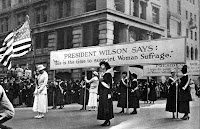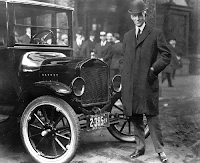Women in Men's World 1869
The Wright Brothers 1903
In the early twentieth century, feminists were still seeking the right to vote. In 1869, African-American men were given the right to vote through the Sixteenth Amendment while women of all races were still excluded. Women recognized one ideal: universal emancipation. The idea was that once the Civil War was won by the North, and the Union was preserved, African Americans would be enfranchised as voting citizens, and woman would naturally gain the same rights. However, after the war was over and slavery was abolished, the women's rights movement was betrayed. Along with white men, black men who pushed for change in the constitution decided to cut off funding for any efforts to win the vote for women (Schwartz p.30). The Fourteenth Amendment, which protected the citizenship of black men, specifically defined as "male" which prompted the 15th Amendment, which guaranteed black men, as citizens, the right to vote. Women lacked the opportunity to vote, and be recognized as citizens. The women of the United States, denied for one hundred years the only means of self-government--the ballot--are political slaves (Schwartz, p. 39). Women did not get the right to vote in all of the Western states. In July of 1917, the woman's suffrage movement went to the extreme. A team of women suffragist tried to storm the White House. These women were arrested, but President Woodrow Wilson pardoned them because he was sympathetic to their plight. A constitutional amendment--the Nineteenth--was submitted to the states, and in 1920, it gave women the right to vote in every state.
The Wright Brothers 1903
William and Orville Wright were two brothers from America who changed the world with their vision of flying through the sky. The Wright brothers owned a bicycle business in Dayton, Ohio in 1892. There were many bicycles but none with wings built. The Wright brothers went to Kitty Hawk, North Carolina and developed the world's first powered, sustained, and controlled flights with a machine they had built (Weigand, p. 222). The Wright brothers finally realized their vision of powered human flight in 1903 (Zacharias, p.56). The airplane revolutionized the entire world, families could cross the ocean in a short time. However, the airplane was also used to tear families apart, and making international warfare more possible. The airplane revolutionized international business, and travelers were set on a path that would lead beyond Earth. The Wright Brothers Fly the First Heavier-than-Air Craft: December 17, 1903.
Henry Ford 1903
Henry Ford Establishes a Car Manufacturing Company in 1903. Ford built the Model T, which is considered the first affordable car for the common person. He pioneered assembly-line production techniques that drove down the price of his cars. Ford revolutionized automobile production. He provided a more affordable car for common people. Ford inspired other car makers, and both changed American lifestyle. An average family could travel, which created a new sense of independence and self-esteem. By the end of the 1920s, it could be argued that the automobile had become the single most dominant element in the U.S. economy (Wiegand, p 221).
Arts and Crafts Movement
The idea for the Arts and Crafts movement began with the promise to maintain traditions of art until the time when true craftsmanship and social production would be indistinguishable. The goal was to restore labor and eliminate alienation. The idea that machines would be able to mass produce items faster, was a major concern for the founder of the movement, William Morris. Society had to be reconstructed to view art as a necessity. Morris strived to revive the hand production and prove that craftsman could be progressive. The main reason for the movement was a response to commercialism " they rebelled against the turning of men into machines, against artificial distinctions in art, and against making the immediate market value, or possibly of profit, the chief test of artistic merit" (Morrison, p. 13). In other words, Morris and his followers believed in supporting the artistic work of designers and craftsmen. Morris' leaders included a designer Walter Crane and bookbinder T. J. Cobden-Sanderson. They each considered themselves socialists. The Arts and crafts movement strove to return to handicraft methods and avoid competitive commercial management; arts and crafts would bring art into the everyday work of the industrial classes, humanizing and beautifying the industry in the process (Morrison, p. 14).
The Oz Series
Wizard of Oz (1899-1900)
The first book in the Oz series in entitled The Wizard of Oz and is written by L. Frank Baum, and illustrated by W.W. Denslow. This book introduces readers to the land of Oz, through the experiences of a little girl named Dorothy Gail. Baum's work is considered a fairy tale and an original story because it focuses on two entirely different lifestyles 1.)"the grim naturalistic picture of a poor Midwestern farm," "the vastness of the prairie, its lack of trees, its drought, its loneliness, its liability to cyclones, and the effects of these conditions upon those who lived there, (Rogers, p. 73) and 2.) the magical, technological "Emerald City of Oz". The Emerald city is the fantasy portion that appears to represent the current day White City--the 1893 Columbian Exhibition in Chicago, that was later torn down. The exhibition was meant to show people what an ideal city could be. This is what the first Oz book represents two different lifestyles: the grey town of Kansas, and the new green and colorful town of the Emerald City. Baum's Emerald City is a fantasy city, just as the White City was a fantasy, a glimpse of the future for Americans.
Education
The Land of Oz was published in 1904, which is a time where children were heavily educated: "Educators thought that children should read realistic books with useful lessons" ( Carpenter, p. 133). The Oz books were not considered educational, but rather fairy tale books with no importance. In this case, the Oz books were censored from the very on site of the series. So, how could the books be so popular (best-selling children's book), if the books were censored? These books reflect today's fantastical series--Harry Potter. There was much controversy when the book was published, and many schools banned the book for its witchcraft theme. According to Carpenter, in Baum's lifetime, fantasy was unpopular, especially in the early 1900s. Librarians of the period believed that series books were bad, because "if a child read one Oz book, that child expected to read them all!" Many libraries i in history banned the Oz books:
1957
"Florida State Librarian Dorothy Dodd made news when she listed Oz and other series as "poorly written, untrue to life, sensational, foolishly sentimental and consequently unwholesome for the children in your community" (Carpenter, p. 134).
1980s
Critics called the Oz series offensive. Many characters from The Patchwork Girl were stereotypes of African Americans.
1986
Christian families filed suit against publish schools for having The Wizard of Oz books as required reading in elementary classes. The parents did not want their children reading about witches. They also felt that the female characters were assuming male roles, and animals were elevated to human status. Luckily, the judge ruled that the book will stay in the schools, and that the parents can remove their children from classes where the materials were used.





No comments:
Post a Comment